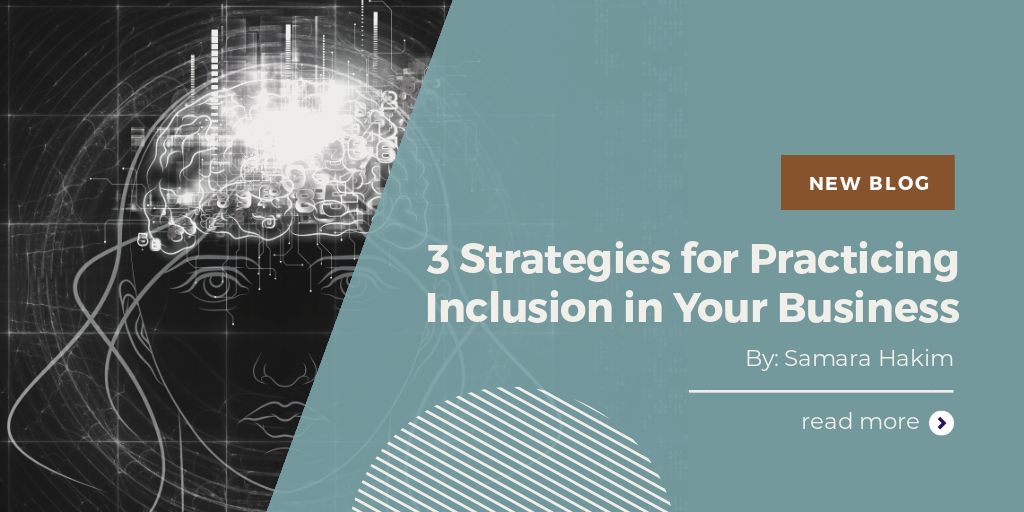
Small businesses, entrepreneurs, and start-ups may feel that organizational strategies for Diversity and Inclusion (D&I) are not for them because they lack the bandwidth in size or resources. However, an advantage for these businesses could be their size, allowing for more visibility of the efforts on the team and in their branding. For leaders, the impact of their individual actions can also be felt more strongly.
Let me start by defining Diversity and Inclusion. Diversity is having differences, whether they are visible or invisible. Inclusion is providing the space (physically and psychologically) for everyone to belong and thrive because the differences are shared, acknowledged, respected, and leveraged towards achieving common goals. The research is extensive on the benefits of D&I for those companies that are truly and consistently inclusive. Budget and size are not the determinant factors.
Here are three strategies to integrate inclusion into your business’s everyday practices and operations:
Make Diversity & Inclusion one of your core values.
To sustain company culture, we need to align and measure “what we do” with “what we say we stand for”. Standing for D&I sets the expectation and allows important conversations to happen during the onboarding process. It is also a statement that we expect everyone to embody D&I daily in their role. To join an initiative, most of us need to understand its value and how to apply it in our own context.
During onboarding, we ask people about their background and skills; passions or dreams in the coming years. Once onboard, those questions often cease. The skills we sought and the aspirations we wanted to nurture become lost in the daily pressures. New ideas are killed without explanation, which then stifles innovation as decisions go unchallenged. When D&I is a value, we are saying “We want new and different ideas, and we commit to creating the space to explore them in many different ways.” Then, we actually do that.
[bctt tweet=”When Diversity and Inclusion is a value, we are saying “We want new and different ideas, and we commit to creating the space to explore them in many different ways.” — Samara Hakim,” username=”@culturgrit”]
Practice it every day.
Leaders who are emotionally and culturally intelligent can regularly mitigate bias in their decisions and effectively communicate how they value their team members, just as they are. After all, they hired the best talent! They have the mindset and behaviors for inclusion. They revisit career aspirations; prioritize the goal over ego; show empathy, give credit where due; mentor and give feedback that the listener can understand; acknowledge the impact of their words and actions (beyond their own intentions); provide the space for pausing and taking stock of what happened, processing mistakes, slights or snubs; recognize small wins every day; solicit feedback and ideas, in a culturally appropriate way. When D&I is a daily practice, it will become consistent.
Tie it to business objectives.
Cultural and identity diversity needs to be integrated into all aspects of the business, internally and externally, and inclusion needs to be tied to business objectives. If you need to grow a specific market, onboarding or collaborating with those who have insights into the market makes sense. For R&D, diverse sources are key.
Internally, ask these questions as part of your decision-making process:
- Who is missing from this conversation?
- What characteristics would they have?
- What might their perspective be?
Externally, ask:
- How do we use D&I as a performance measure?
- Do we have a diverse network?
- Is our need for affinity effectively excluding different communication or working styles?
- How many “clones” of me are around?
- How diverse are our partners and vendors? What is their approach to inclusion?
Having a D&I manager, committee, or consultant can help with metrics and accountability. For corporate suppliers, clients might expect you to show your inclusion efforts align with theirs. With brand perception being discussed so publicly these days, inclusion and social responsibility have become business objectives themselves, especially for those seeking investors.
These D&I strategies are not just a “trend”. They allow your business to purposefully develop the agility and grit necessary to scale innovation and business outcomes.
 Samara Hakim, JD, is the President of CulturGrit, LLC. She is an international culture and inclusion thought leader, data strategist, speaker, writer, and facilitator. For over a decade, Samara has been equipping leaders with the cultural intelligence to work with those who are different than them by mitigating bias and integrating culture into business metrics. She has worked on projects for Fortune 500 and 100 companies, start-ups, educational institutions, and non-profits. She has facilitated workshops in multiple languages, and she thrives on working with people from all walks of life. Samara was honored with the 2018 Women of Excellence Entrepreneur Award by Diversity Professional Magazine and the 2019 American Honda Premier Partner Award. To learn more about the work that CulturGrit is doing, please visit www.culturgrit.com or email Samara at samara@culturgrit.com.
Samara Hakim, JD, is the President of CulturGrit, LLC. She is an international culture and inclusion thought leader, data strategist, speaker, writer, and facilitator. For over a decade, Samara has been equipping leaders with the cultural intelligence to work with those who are different than them by mitigating bias and integrating culture into business metrics. She has worked on projects for Fortune 500 and 100 companies, start-ups, educational institutions, and non-profits. She has facilitated workshops in multiple languages, and she thrives on working with people from all walks of life. Samara was honored with the 2018 Women of Excellence Entrepreneur Award by Diversity Professional Magazine and the 2019 American Honda Premier Partner Award. To learn more about the work that CulturGrit is doing, please visit www.culturgrit.com or email Samara at samara@culturgrit.com.





